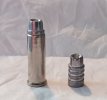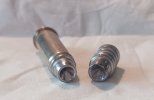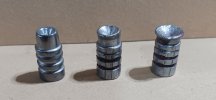Sometimes inspiration can come from the strangest places. A while back I was digging through my cast bullet inventory and I came across a Ziploc bag of bullets that I had cast 15+ years ago and had completely forgotten about. They were cast from an Ideal 358446 mould, a plain-based .38/.357 SWC mould with a healthy base band, two lube grooves, and a crimp groove. The 358446 dates back to the late 1930s, and served as the inspiration behind the popular 358156 GC design that Ray Thompson drew up in the early 1950s, so the nose on the 358446 is short enough to work in all .357 Magnum revolvers. This particular baggie of bullets was interesting because the mould had been modified by Erik Ohlen to drop HP bullets. Erik had installed one of his collared HP pins, with multiple pin profiles included. This particular batch of bullets were cast using the cup point pins. Cup-points are wide-mouthed hollow-points, with shallow conical cavities (multiple mould-makers have subsequently offered moulds to make cup-point bullets). This batch of 358446 cup-points were cast moderately soft, and have a measured BHN of 10.


When the subject of .38 Special snub-nosed revolvers comes up, invariably the question comes up as to what to load them with. For many years, the typical answer was “The FBI Load.”, a swaged lead SWC-HP at 850-900 fps (loaded by Remington, Winchester, and Federal). The FBI load developed a reputation for expanding well when fired from longer barreled revolvers, with little if any expansion from the 2” snubbies. These loads have been dropped from production, but similar .38 Special lead HP loads are currently offered by Underwood and Buffalo Bore (and Buffalo Bore has one +P load that is loaded notably warmer for positive expansion from all barrel lengths).
In recent years, it has become popular to recommend full wadcutters, loaded to full standard .38 Special pressures (i.e. not light target loads) for defensive use, and a number of manufacturers offer 148 grain wadcutters loaded to 850-900 fps as personal defense loads. Accuracy of these loads is very good. With a large blunt meplat, wadcutters offer excellent terminal performance. Recoil is very manageable for most shooters. The main drawback to these loads is the flat-nose of the wadcutter makes reloads under stress more difficult, so some people recommend that wadcutter ammo be used for the initial carry load, and then assemble any reloads using a more speed-loader friendly bullet profile. It might be argued that changing loads in the middle of a fight could be a problem, but as long as the two loads shoot to the same point of impact it seems like a reasonable strategy to me.
What does all this have to do with a bag of cup-pointed cast bullets? Well, expansion of a HP bullet is a hydraulic event. Fluids from soft tissue get inside the cavity and hydraulic pressure pushes the walls of the bullet’s nose outward, then the pressure dam building up in front of the bullet pushes the mushroomed nose outward and back. For a cup-pointed bullet, that first step has essentially already been done in the bullet mould. It doesn’t matter if the cup fills up with denim, the wide-open nose can still be battered flat. Like a wadcutter. It’s the flat nose that crushes soft tissue and creates a permanent wound channel. The cup-point cast bullet packages this latent wadcutter meplat in a SWC bullet profile, that works just fine speedloaders. If cast soft enough, these cup-points should expand at .38 Special snub-nose velocities. It was time to load some ammo and find out.
Bullets weighed 156 grains as cast. They were sized .357” and lubed with homemade moly lube (50/50 beeswax/moly grease). Ammo was loaded into Federal +P cases, and primed with WSP primers.
.38 Special +P load -- 8.4 grains of HS-7 (~19,000 CUP, Hodgdon 26th)—measured velocities 1079 fps (4”), 1004 fps (3”), 977 fps (2”). Yes, I know that HS-7 has been discontinued. I used it because it is very well suited for +P loads in this pressure regime, because I have a lot of experience with similar loads, and because I have a lot of HS-7. If I ever run out, I will work up something similar using a powder of similar burn rate (e.g. AA #7, N350, Longshot, Blue Dot, etc.).
.38 Special Standard pressure load -- 6.5 grains of HS-6 (14,400 CUP, Hodgdon 26th) – measured velocities 900 fps (4”), 863 fps (3”), 838 fps (2”)
Accuracy testing was carried out at 50 feet, off of sandbags, for the 4” and 3” revolvers, and at 25 feet for the 2” DAO Model 64 (also off of sandbags). These loads shot to the sights in these fixed sight guns, and groups were more than adequate for defensive concealed carry.
Expansion testing was carried out using 1-gallon heavy duty polyethylene jugs filled with water (these had formerly been vinegar jugs). These water jugs were backed with a cardboard box stuffed with old sheets to catch the expanded slug. Each jug was shot in the center, from about 10 feet away. Each bullet penetrated about a 6” water bath.
At 850 fps, the nose of these cup-points riveted, basically opening to a wadcutter profile. At 1000 fps, these cup-points expanded to almost .40 caliber. There was virtually 100% weight retention at both velocities (only weight lost was bullet lube). BHN of 10 appears to be just a bit too hard for this application. BHN of 8 (e.g. 30-to-1 lead to tin, or 1-to-1 WW to pure lead) might be better suited to cup-point bullets in .38 Special snub-nosed revolvers.

Left, as-cast. Center, 850 fps. Right, 1000 fps.


When the subject of .38 Special snub-nosed revolvers comes up, invariably the question comes up as to what to load them with. For many years, the typical answer was “The FBI Load.”, a swaged lead SWC-HP at 850-900 fps (loaded by Remington, Winchester, and Federal). The FBI load developed a reputation for expanding well when fired from longer barreled revolvers, with little if any expansion from the 2” snubbies. These loads have been dropped from production, but similar .38 Special lead HP loads are currently offered by Underwood and Buffalo Bore (and Buffalo Bore has one +P load that is loaded notably warmer for positive expansion from all barrel lengths).
In recent years, it has become popular to recommend full wadcutters, loaded to full standard .38 Special pressures (i.e. not light target loads) for defensive use, and a number of manufacturers offer 148 grain wadcutters loaded to 850-900 fps as personal defense loads. Accuracy of these loads is very good. With a large blunt meplat, wadcutters offer excellent terminal performance. Recoil is very manageable for most shooters. The main drawback to these loads is the flat-nose of the wadcutter makes reloads under stress more difficult, so some people recommend that wadcutter ammo be used for the initial carry load, and then assemble any reloads using a more speed-loader friendly bullet profile. It might be argued that changing loads in the middle of a fight could be a problem, but as long as the two loads shoot to the same point of impact it seems like a reasonable strategy to me.
What does all this have to do with a bag of cup-pointed cast bullets? Well, expansion of a HP bullet is a hydraulic event. Fluids from soft tissue get inside the cavity and hydraulic pressure pushes the walls of the bullet’s nose outward, then the pressure dam building up in front of the bullet pushes the mushroomed nose outward and back. For a cup-pointed bullet, that first step has essentially already been done in the bullet mould. It doesn’t matter if the cup fills up with denim, the wide-open nose can still be battered flat. Like a wadcutter. It’s the flat nose that crushes soft tissue and creates a permanent wound channel. The cup-point cast bullet packages this latent wadcutter meplat in a SWC bullet profile, that works just fine speedloaders. If cast soft enough, these cup-points should expand at .38 Special snub-nose velocities. It was time to load some ammo and find out.
Bullets weighed 156 grains as cast. They were sized .357” and lubed with homemade moly lube (50/50 beeswax/moly grease). Ammo was loaded into Federal +P cases, and primed with WSP primers.
.38 Special +P load -- 8.4 grains of HS-7 (~19,000 CUP, Hodgdon 26th)—measured velocities 1079 fps (4”), 1004 fps (3”), 977 fps (2”). Yes, I know that HS-7 has been discontinued. I used it because it is very well suited for +P loads in this pressure regime, because I have a lot of experience with similar loads, and because I have a lot of HS-7. If I ever run out, I will work up something similar using a powder of similar burn rate (e.g. AA #7, N350, Longshot, Blue Dot, etc.).
.38 Special Standard pressure load -- 6.5 grains of HS-6 (14,400 CUP, Hodgdon 26th) – measured velocities 900 fps (4”), 863 fps (3”), 838 fps (2”)
Accuracy testing was carried out at 50 feet, off of sandbags, for the 4” and 3” revolvers, and at 25 feet for the 2” DAO Model 64 (also off of sandbags). These loads shot to the sights in these fixed sight guns, and groups were more than adequate for defensive concealed carry.
Expansion testing was carried out using 1-gallon heavy duty polyethylene jugs filled with water (these had formerly been vinegar jugs). These water jugs were backed with a cardboard box stuffed with old sheets to catch the expanded slug. Each jug was shot in the center, from about 10 feet away. Each bullet penetrated about a 6” water bath.
At 850 fps, the nose of these cup-points riveted, basically opening to a wadcutter profile. At 1000 fps, these cup-points expanded to almost .40 caliber. There was virtually 100% weight retention at both velocities (only weight lost was bullet lube). BHN of 10 appears to be just a bit too hard for this application. BHN of 8 (e.g. 30-to-1 lead to tin, or 1-to-1 WW to pure lead) might be better suited to cup-point bullets in .38 Special snub-nosed revolvers.

Left, as-cast. Center, 850 fps. Right, 1000 fps.
